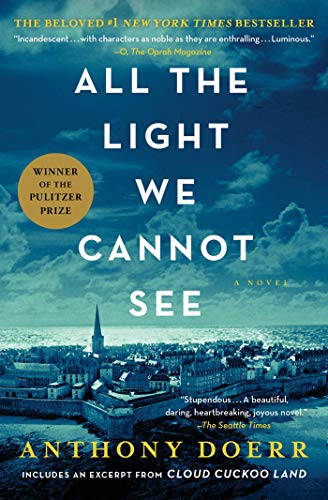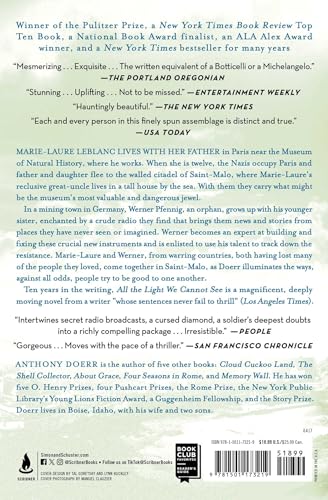Hey folks, Steve here! If you ever wanted to get swept up in a story with blind French girls, brainy German boys, and a war that really needed to take a chill pill, then you’ve come to the right review. Today I’m cracking open the pages of “All the Light We Cannot See” and, let me tell you, my friends and I had a real book club moment over this one (snacks included). Spoiler: some tears were shed, mostly when we ran out of chips. But before you run off to spend your hard-earned cash, I’ll walk you through the characters, wartime setting, storytelling style, and why hope and survival matter more than who wins the next argument about who gets the last cookie. Let’s get this review rolling!
In a nutsheel
All the Light We Cannot See is a historical fiction book by Anthony Doerr. This one is set during World War II, but don’t worry—it’s not all about battles and bombs. Instead, it zooms in (like a camera, not the app) on the lives of two young people who seem worlds apart: a blind French girl and a German boy who loves radios.
The story jumps between their journeys, showing how they face tough choices, loss, and the search for hope. Doerr fills the book with themes of survival, courage, and the weird connections that bind us even when the world is falling apart. There’s a sprinkle of mystery, a touch of sadness, and lots of moments that made me stop, look up, and question why onions always make me cry (even when I’m not cutting them).
If you like beautifully written stories that make you feel stuff but don’t hit you over the head with complicated words, this book will keep you flipping pages late into the night.
Characters and Their Emotional Journeys in All the Light We Cannot See
Let’s talk about the people in All the Light We Cannot See—because, let’s be honest, the real magic here is in their hearts, not just the plot. First up is Marie-Laure, a French girl who’s blind but sees the world in her own bright way. I cheered for her as she used her wits and bravery to make sense of life during World War II. My own eyesight is fine, but after reading about her, I felt like I needed to get my ears checked. She listens better than I ever could!
Then there’s Werner, a German orphan with a knack for fixing radios—and getting tangled in moral knots. His journey isn’t just about crossing borders but about wrestling with guilt, hope, and a dash of fear. I have to admit, I related a little when he made bad choices under pressure. (Don’t ask me about my brief but disastrous attempt at competitive hotdog eating.) Werner really got me thinking: how do you know what’s right when everyone around you is shouting otherwise?
Both characters feel painfully real. Sometimes Marie-Laure’s hope seems like it’ll crack, and Werner’s confusion makes you want to shake him, but that’s life, isn’t it? Not everyone becomes a hero in a straight line. The people in this book are shaped by loss, kindness, and a hefty dose of wartime chaos. I found myself rooting for them, yelling at them, and sometimes even talking to the page like a weirdo. The author, Anthony Doerr, takes these emotional journeys and turns them into something almost touchable. The downside? At times, the feelings get a bit dense. You might need to take a breather or three just to process.
Ready for the next part? Hold onto your helmets, because we’re about to explore the historical setting and wartime atmosphere that shapes every choice these characters make!
Exploring the Historical Setting and Wartime Atmosphere in All the Light We Cannot See
One thing that really shines in All the Light We Cannot See is the way the author paints the historical setting. I felt as if I had dust on my face and my shoes stuck in the rubble of World War II France. The book brings the cities of Saint-Malo and Paris to life, making them more than backdrops—they become part of the story. You can almost smell the salt water as Marie-Laure moves through the small streets of Saint-Malo. Trust me, I tried pretending my kitchen was Saint-Malo for an afternoon. My cat was not impressed, but I was!
The wartime atmosphere in this book is no joke. You get both the pain and the strange beauty that comes out during war. I could feel the fear when the bombs started falling, and the strange calm that follows each raid. The author gives us ration cards, secret radios, and blackout curtains. Even the food (or lack of it) gets attention. You start to miss fresh bread like the characters do. The detail is so real that I now eat stale toast for fun—well, not really, but you get what I mean.
The historical setting in All the Light We Cannot See is more than just a backdrop. It shapes everything—the characters, the plot, and even the small moments of hope. If you love to feel like you’re living history while staying in your armchair, this book nails it. Up next: How does the author keep the story moving? Stay tuned, because we’re about to find out if the storytelling style sprints, crawls, or does a fancy tap dance!
Storytelling Style and Pacing in All the Light We Cannot See
Let me tell you, the storytelling style in All the Light We Cannot See is like eating a fancy cake one crumb at a time. Anthony Doerr chops his chapters up into tiny bites, and you can’t help but keep turning the pages. One chapter you’re in bombed-out Saint-Malo, snooping around with Marie-Laure, and the next you’re hanging out in a German orphanage with Werner. I felt like I was at a party where every guest is from a different country and no one gets bored for too long.
The pacing, though, is a roller coaster. Sometimes the story moves fast—like when Werner is dodging trouble or Marie-Laure is hiding from people with very bad intentions. Other times, it slows right down and zooms in on tiny things, like a sea shell or a radio signal. That’s when I found myself staring at a wall, thinking about snails (don’t ask, it’s a thing in the book). It isn’t always perfect. Sometimes I wanted the story to speed up but it just wouldn’t budge. But I never felt like quitting, not even during the slow parts. It’s like crocheting a blanket—sometimes repetitive, but then you stand up and see, wow, this thing is actually pretty cool.
So, the storytelling and pacing in All the Light We Cannot See can be a mixed bag, but it’s mostly filled with good stuff and a few raisins. Next up, let’s crack open the themes of hope and survival—bring your flashlight, because things are about to get deep!
Themes of Hope and Survival in All the Light We Cannot See
Hope and survival spin around each other like two dance partners in All the Light We Cannot See. I found myself rooting pretty hard for Marie-Laure and Werner, even when things looked as bleak as my goldfish bowl during a power cut. The book serves up hope by the spoonful, even amidst all the grim stuff happening in World War II. If there’s one thing I learned, it’s that the human spirit can be as stubborn as my old neighbor’s cat.
Hope pops up in small ways. Marie-Laure listens to distant radio broadcasts, clinging to every word like it’s a lifeline. Werner dreams of more than what fate (and a terrifying orphanage) handed him. Yes, the book sets its characters in rough spots, but it never feels pointlessly cruel. Instead, hope glimmers in the dark, like when you find the last cookie at the back of the cupboard. Is that melodramatic? Maybe. But that’s what the story feels like!
The survival part isn’t just physical—though dodging bombs is no easy feat. It’s about hanging on to kindness, memory, and imagination. Even after all the loss, the characters try to keep their sense of wonder intact. It’s almost enough to make you believe that humanity might not be all bad, even if we’re running low on cookies and optimism.
Do I recommend All the Light We Cannot See? You bet! It’s a hopeful, human story that will weather even the most overstuffed bookshelf. Grab it before your neighbor’s cat does.
Conclusion
Alright folks, that’s the end of my review for All the Light We Cannot See. This book packs a punch with touching characters, a rich wartime backdrop, and a story that keeps you hooked (even if I sometimes lost track of all the timelines—I blame my snack breaks). Anthony Doerr gives us hope and heartbreak with some serious style. I recommend it for anyone who loves moving stories and maybe wants to feel a bit smarter at their next book club. It’s not perfect—some parts drag and there are a few too many blind metaphors—but it’s a book I’m glad I read and now proudly force on my friends. Until next time, keep your bookmarks handy and your snacks closer!



